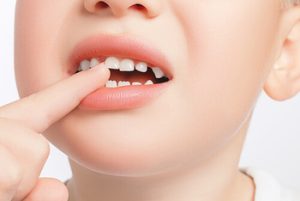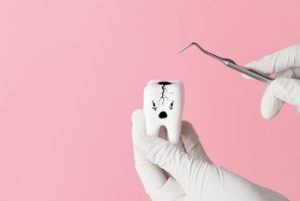Tooth decay in children is a widespread yet preventable condition that can significantly affect a child’s health, comfort, and development. Also known as early childhood caries, this form of dental decay primarily affects young children and can begin as soon as the first tooth appears. Despite being entirely preventable, tooth decay remains one of the most common chronic conditions among children.
Understanding how and why tooth decay occurs in children’s teeth is essential for parents, carers, and guardians. Taking a proactive approach to oral health from infancy can help children maintain their own teeth into adulthood and avoid the pain and complications associated with poor oral hygiene.
What Causes Tooth Decay in Children?
Tooth decay occurs when bacteria in the mouth feed on sugars from food and drinks, producing acid that erodes the tooth enamel. This process starts with early signs such as white spots or discolouration on the tooth surface and can progress to more severe stages like broken teeth, advanced decay, and even infections if left untreated.
In children, the risk of dental caries is increased due to several factors:
- Regularly eating sugary snacks and drinking sweet beverages
- Prolonged bottle-feeding or breastfeeding, particularly at night
- Dip dummies in honey or sugary substances
- Poor oral hygiene and irregular brushing habits
- Less saliva flow during sleep, which reduces the mouth’s natural ability to neutralise acids
These habits can result in very early stages of decay, which may not be visible without a dental check-up. If early tooth decay is not identified and managed promptly, it can escalate into severe dental problems that impact a child’s overall health.
The Importance of Baby Teeth
Some may believe that baby teeth (also known as primary teeth) aren’t as important because they eventually fall out. However, baby teeth play a crucial role in a child’s mouth. They help in proper chewing and speech development and act as placeholders for adult teeth. When baby teeth are lost too early from decay, it can cause the adult teeth to become crowded or misaligned incoming adult teeth.
Caring for a baby’s teeth from the moment the first tooth appears sets the stage for a lifetime of good oral health. This involves more than just cleaning teeth; it’s about building habits that prevent tooth decay from taking hold early in life.
Early Signs and Symptoms of Tooth Decay
Recognising early signs of dental decay in children is key to preventing more severe damage. Some indicators include:
- White, yellow or brown spots near the gum line
- Discomfort or pain when consuming hot, cold, or sweet foods
- Persistent bad breath despite regular brushing
- Visible pits or holes in the teeth
- Difficulty chewing or reluctance to eat
Early detection through regular dental check-ups helps catch problems in the very early stages before they worsen. A dentist can examine your child’s teeth and recommend the most appropriate treatment or preventative care.
Preventing Tooth Decay in Children
Preventing tooth decay requires a combination of healthy eating, good oral hygiene, and regular visits to an oral health professional. Here are key strategies:
1. Brushing Teeth and Oral Hygiene
 Begin brushing as soon as the first tooth appears, using a soft toothbrush with a pea-sized amount of fluoride toothpaste for children aged two and above. For children under two, consult a dental professional before introducing fluoride toothpaste.
Begin brushing as soon as the first tooth appears, using a soft toothbrush with a pea-sized amount of fluoride toothpaste for children aged two and above. For children under two, consult a dental professional before introducing fluoride toothpaste.
Encourage children to brush their teeth twice a day – once in the morning and again before bed. Brushing should focus on the gum line and every part of each tooth to clear away plaque and prevent decay.
As children grow, introduce dental floss to clean between teeth where a toothbrush can’t reach. Children should continue using a soft toothbrush and fluoride toothpaste appropriate for their age.
2. Healthy Diet and Food Choices
Nutritious eating is essential for preventing tooth decay. Help kids enjoy a wide range of healthy foods, including vegetables, fruits, dairy, and whole grains. Limit the intake of sugary foods and avoid sugary snacks between meals.
Avoid sweet drinks such as cordial, soft drinks, and fruit juice, especially for young children. Tap water is the best drink for hydration and, in many areas, contains fluoride that helps strengthen tooth enamel.
If your child requires medication, choose sugar-free medicines where possible. Always double-check and ask to choose sugar-free medicines to minimise the risk of decay.
3. Feeding Practices and Oral Habits
It’s important to avoid prolonged bottle feeding or letting children fall asleep while feeding, as this can expose teeth to sugars for long periods. Encourage your child to finish feeding before going to bed and avoid dipping dummies in sweet substances.
From early childhood, develop a consistent routine for cleaning teeth and reinforce the importance of good dental care.
4. Dental Check-Ups and Professional Support
 Routine dental check ups should begin from the age of one or within six months of the first tooth appearing. These appointments allow for early detection of problems and give parents helpful advice about maintaining good oral health practices.
Routine dental check ups should begin from the age of one or within six months of the first tooth appearing. These appointments allow for early detection of problems and give parents helpful advice about maintaining good oral health practices.
A dental professional can apply fluoride treatments or sealants to protect tooth surfaces that are commonly affected by decay. Regular dental visits also help children become comfortable with the process, reducing anxiety and encouraging lifelong habits.
The Australian Dental Journal recommends regular dental assessments as a key element of preventative care. Dental health services are equipped to meet the unique needs of children’s teeth and can provide tailored dental treatment plans when needed.
Managing Dental Decay: Treatment Options
If a child develops dental caries, early treatment is crucial to avoid further complications. Depending on the severity, dental treatment may include:
- Fluoride applications to help remineralise tooth enamel in the early stages
- Fillings or crowns to restore decayed teeth
- Extraction in different cases where the tooth is beyond repair
- Space maintainers, if a baby tooth is lost prematurely to guide adult teeth into the proper position
Leaving dental decay untreated can lead to pain, infections, difficulty eating, and speech problems. In some cases, it can affect a child’s overall health and well-being, highlighting the importance of early intervention.
Special Considerations for Different Age Groups
While young children are most vulnerable, older children are not immune to dental decay. As children grow, their dietary choices and hygiene habits can change, sometimes for the worse. Teens, in particular, may consume more sugary drinks or snack frequently, increasing their risk.
Dental health education should continue throughout childhood and adolescence. Reinforcing habits like brushing teeth twice a day, regular dental checks, and avoiding sugary foods remains essential.
Final Thoughts
Children’s tooth decay can be avoided with awareness, commitment, and routine care. From the first tooth to the arrival of adult teeth, every stage of a child’s dental development matters. With the right habits, regular dental check ups, and professional support, families can help children maintain strong, healthy smiles for life.
Good dental care begins at home. By focusing on cleaning teeth, encouraging healthy eating, choosing sugar-free medicines, and making dental health a priority, we can protect our children’s oral health and reduce their risk of decay.
If you’re concerned about your child’s dental health or want to prevent tooth decay, book a consultation with Beyond Infinity Dental at (02) 8806 3799.
References
- Cleveland Clinic. (2023). ‘Fluoride’. Cleveland Clinic, 13 March. Cleveland, OH: Cleveland Clinic Foundation. https://my.clevelandclinic.org/health/diseases/23227-fluorosis
- Cherney, K. (2022). ‘Baby Bottle Tooth Decay (Infant Caries)’. Healthline, 30 November. San Francisco, CA: Healthline Media. https://www.healthline.com/health/tooth-decay-early-childhood#causes
- Centers for Disease Control and Prevention. (2020). ‘About Dental Sealants’. CDC, 5 October. Atlanta, GA: U.S. Department of Health and Human Services. https://www.cdc.gov/oral-health/prevention/about-dental-sealants.html#:~:text=Overview,can%20last%20for%20many%20years.
- Welti, R. et al. (2023). ‘Oral health messages for Australia: A national consensus statement’. Australian Dental Journal, 4 September. Sydney, NSW: Australian Dental Association. https://onlinelibrary.wiley.com/doi/10.1111/adj.12973









